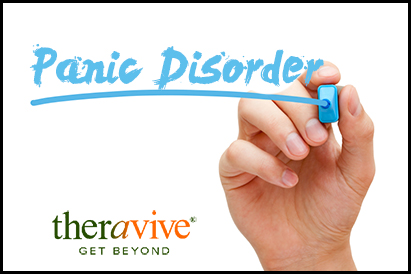 Many of us have probably heard someone say, “I had a panic attack”, but what does this really mean? For some, the experience of panic is actually part of a mental illness called Panic Disorder. Unless you have experienced this disorder, it can be easy to minimize it, or misunderstand what it is really all about. It’s estimated that Panic Disorder impacts the lives of about 2.4 million Americans, with women being more likely to have the disorder than men (Panic Attacks and Panic Disorder, 2014).
Many of us have probably heard someone say, “I had a panic attack”, but what does this really mean? For some, the experience of panic is actually part of a mental illness called Panic Disorder. Unless you have experienced this disorder, it can be easy to minimize it, or misunderstand what it is really all about. It’s estimated that Panic Disorder impacts the lives of about 2.4 million Americans, with women being more likely to have the disorder than men (Panic Attacks and Panic Disorder, 2014).
Often, the first episodes of panic happen in adolescence or early adulthood, and it’s common for people to be unable to identify a specific trigger for the attack (Panic Attacks, 2014). Understanding that Panic Disorder is a real, diagnosable mental illness is important for people who live with the disorder, as well as their loved ones. It is not a weakness or a character flaw. Panic Disorder can become truly debilitating, but effective treatment is available to help minimize the impact of the disorder on daily life.
Understanding Panic
Experiencing panic can be very frightening and disorienting. People who live with panic describe it in many different ways, but there are some common symptoms that are identified to diagnose the disorder. The symptoms of a panic attack can be both emotional and physiological and usually last about 5-15 minutes (but can last longer) and may include:
-
A fear that you are losing control or are about to die
-
Difficulty breathing
-
Pounding heart or chest pain
-
Intense feeling of dread
-
Sensation of choking or smothering
-
Dizziness or feeling faint
-
Trembling or shaking
-
Sweating
-
Nausea or stomachache
-
Tingling or numbness in the fingers and toes
-
Chills or hot flashes
It’s easy to see how these symptoms could be confused with medical issues like a heart attack, and many people do present in emergency rooms with panic attacks. They can be very frightening. Another key component of Panic Disorder is the fear of having panic attacks in the future (Panic Attacks, 2014). The experience of panic is so awful that it generates a fear that it will happen again, potentially creating a vicious cycle of anxiety and panic. In her article in the Huffington Post (2014), Sarah Fader describes her experience of panic in this way:
“I had my first panic attack when I was 15 years old and (at the time) I had no idea what was going on. I thought I might be having a heart attack. It seemed like a physical problem at first. I had an uncontrollable racing heart followed by sweating and shaking. But then I quickly realized that nervous thoughts were accompanying my physical symptoms. From ages 15 to 18, I suffered from severe panic attacks that made it incredibly difficult for me to function” (Fader, 2014).
Another symptom of Panic Disorder can be Agoraphobia. The cause of Agoraphobia is not known, but it tends to happen when fear of another panic attack develops. Agoraphobia can also severely impact a person’s functioning, and can include all or some of these symptoms (Board, 2014):
- Being afraid of spending time alone
- Being afraid of places where escape might be hard, especially crowded places
- Being afraid of losing control in a public place
- Depending on others
- Feeling detached or separated from others
- Feeling helpless
- Feeling that the body is not real
- Feeling that the environment is not real
- Having an unusual temper or agitation
- Staying in the house for long periods of time
It’s easy to see how untreated panic attacks and agoraphobia can significantly limit the ability to work, attend school, or complete daily responsibilities like parenting. One person describes her experience with panic and agoraphobia like this:
"One day, without any warning or reason, I felt terrified. I was so afraid. I thought I was going to die. My heart was pounding and my head was spinning. I would get these feelings every couple of weeks. I thought I was losing my mind. The more attacks I had, the more afraid I got. I was always living in fear. I didn't know when I might have another attack. I became so afraid that I didn't want to leave my house" (Panic Disorder, 2014).
Panic can also be a component of other mental illnesses such as depression, generalized anxiety disorder, obsessive–compulsive disorder, post-traumatic stress disorder, and some personality disorders (Panic Attacks, 2014).
 Debunking Some Myths
Debunking Some Myths
Thankfully, the symptoms of Panic Disorder are treatable and people with this illness can live full, happy, and productive lives. In fact, there are a number of famous people who are doing, or have done great things in spite of anxiety or panic disorder, including Johnny Depp, Kate Moss, David Beckham, and Howie Mandel. It’s also thought that Abraham Lincoln may have experienced panic in addition to depression (13 Famous People with Anxiety Disorders, 2014). Understanding Panic Disorder means demystifying it and debunking some of the myths about the disorder.
- Myth #1: Panic attacks can make you go “crazy” or lose control of yourself. This is simply not true. Panic attacks do lead to very uncomfortable and upsetting thoughts and feelings, but they do not lead to a total loss of touch with reality. Feelings like de-realization and depersonalization, which can be part of panic, can be extremely uncomfortable, but are not the same as psychosis.
-
Myth #2: Panic disorder is a sign of weakness, a character flaw, or an inability to control emotions. This belief can really discourage a person with Panic Disorder, and invalidate their experience with the illness. While the exact cause of Panic Disorder is unknown, it is a very real, diagnosable mental illness that responds to treatment with therapy and medication. Most experts currently believe that panic disorder is caused by a combination of factors that include genetic, biological (e.g. hormones, brain chemistry), and environmental influences like stress (Panic Attacks, 2014).
Myth #3: Panic attacks will cause harm to your body. Because there are so many somatic symptoms associated with Panic Disorder, like chest pain and shortness of breath, it can be easy to believe that something is going wrong or being damaged within the body. But, this is not the case, and once the panic subsides, the body returns to normal functioning (Panic Attacks, 2014). It’s very scary to experience these sensations, but it’s important to know that the body is okay, and will recover.
Understanding and accepting that Panic Disorder is a real illness is the first step toward overcoming it, and moving forward. After receiving a diagnosis, there are many things that can be done to alleviate the symptoms and minimize their impact on daily life.
Getting Back to Calm
Once Panic Disorder is accurately diagnosed, and a medical condition is ruled out, it is usually treated with counseling, medication, or a combination of both (Panic Disorder, 2014). Counseling can help people to identify and manage possible triggers for their panic (e.g. stress, lack of sleep, or worry) (Panic Disorder, 2014). Cognitive Behavioral Therapy (CBT) is a type of therapy that can be particularly helpful. As Sarah Fader mentioned in her Huffington Post article, she noticed that “nervous thoughts were accompanying my physical symptoms” (Fader, 2014). Thinking patterns impact feelings and behavior in a big way. CBT can help to increase awareness about thoughts, and change thinking patterns, if needed, to decrease anxiety, panic and agoraphobia.
Exposure therapy is yet another form of counseling that can help people learn how to manage situations that tend to trigger their anxiety and panic. While it may sound scary, exposure therapy exposes the person to the triggering situation (very gradually), until they can effectively manage their panic. This can be a very empowering experience for people who feel that panic has taken over their life (Cognitive-Behavioral Therapy and Panic Disorder, 2014). In counseling, people learn effective coping strategies to decrease the frequency of panic and cope with the distressing feelings that occur during episodes of panic or agoraphobia. Some coping skills for people with panic and agoraphobia include:
· Getting enough quality sleep
· Eating a healthy and balanced diet
· Avoiding caffeine
· Learning relaxation skills (e.g. meditation, progressive relaxation)
· Getting enough exercise
Without treatment, the symptoms of Panic Disorder can increase, and even lead to other anxiety disorders, or depression. Life can become unmanageable as people begin to avoid situations that seem to trigger panic (e.g. grocery shopping). They may also develop anticipatory anxiety, agoraphobia, or even claustrophobia (Panic Disorder, 2014). Medication is frequently prescribed for the symptoms of Panic Disorder. Anti-anxiety medications like Xanax and Klonopin may be used for more short-term relief of acute symptoms, while anti-depressants like Zoloft or Paxil may be used for longer term relief. It’s important to talk with a doctor about what medication may be most helpful. With appropriate treatment, over 90% of people can find relief from their symptoms (Panic Disorder, 2014).
It’s essential that people with the disorder and their family and friends understand this disorder and how it can impact daily functioning. Living with Panic Disorder can be frightening and frustrating, but it doesn’t have to become debilitating. Symptoms are very often manageable with the right treatment and healthy self-care measures.
_________________________________________________________________________________________________________________________________
13 Famous people with anxiety disorders. (2014). Retrieved July 1, 2014, from http://www.calmclinic.com/anxiety/famous-people-with-anxiety-disorder
Board, A. E. (2014, October 03). Agoraphobia. Retrieved June 19, 2014, from http://www.ncbi.nlm.nih.gov/pubmedhealth/PMH0001921/
Cognitive-behavioral therapy and panic disorder. (2014). Retrieved July 5, 2014, from http://www.webmd.com/anxiety-panic/cognitive-behavioral-therapy-and-panic-disorder
Fader, S. (2014, February 02). Fighting against the stigma of mental illness. Retrieved July 1, 2014, from http://www.huffingtonpost.com/sarah-fader/stigma-mental-illness_b_4680835.html
Panic attacks and panic disorder. (2014). Retrieved July 1, 2014, from http://www.webmd.com/anxiety-panic/guide/mental-health-panic-disorder
Panic disorder: When fear overwhelms. (2014). Retrieved July 5, 2014, from http://www.nimh.nih.gov/health/publications/panic-disorder-when-fear-overwhelms/index.shtml